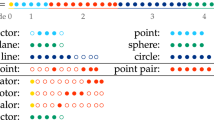
Overview
- Defines geometric algebra computing as the geometrically intuitive development of algorithms with a focus on their efficient implementation
- Author anticipates the forthcoming widespread adoption of parallel processor technology
- New computing platforms can benefit from the inherent optimization and parallelization of the techniques described
Part of the book series: Geometry and Computing (GC, volume 8)
Access this book
Tax calculation will be finalised at checkout
Other ways to access
About this book
The author defines “Geometric Algebra Computing” as the geometrically intuitive development of algorithms using geometric algebra with a focus on their efficient implementation, and the goal of this book is to lay the foundations for the widespread use of geometric algebra as a powerful, intuitive mathematical language for engineering applications in academia and industry. The related technology is driven by the invention of conformal geometric algebra as a 5D extension of the 4D projective geometric algebra and by the recent progress in parallel processing, and with the specific conformal geometric algebra there is a growing community in recent years applying geometric algebra to applications in computer vision, computer graphics, and robotics.
This book is organized into three parts: in Part I the author focuses on the mathematical foundations; in Part II he explains the interactive handling of geometric algebra; and in Part III he deals with computing technology for high-performance implementations based on geometric algebra as a domain-specific language in standard programming languages such as C++ and OpenCL. The book is written in a tutorial style and readers should gain experience with the associated freely available software packages and applications.
The book is suitable for students, engineers, and researchers in computer science, computational engineering, and mathematics.Similar content being viewed by others
Keywords
Table of contents (14 chapters)
-
Front Matter
-
Mathematical Foundations
-
Front Matter
-
-
Interactive and Visual Geometric Algebra Computing
-
Front Matter
-
-
Runtime Performance of Geometric Algebra Computing
-
Front Matter
-
-
Back Matter
Reviews
From the book reviews:
“This textbook addresses students (undergraduate to postgraduate), scientists and engineers with an interest in intuitive and highly efficient computer programs based on W. K. Clifford’s geometric algebras. The book greatly benefits from the original work of the author, and is very readable. … After a general introduction to the benefits of geometric algebra, geometric algebra computing and its historical development, the book is divided into three main parts.” (Eckhard M. S. Hitzer, Mathematical Reviews, May, 2014)Authors and Affiliations
About the author
Dr.-Ing. Dietmar Hildenbrand is a member of the Mathematics Department of the Technische Universität Darmstadt. He is one of the codevelopers of Gaalop (Geometic Algebra Algorithms Optimizer) a software package used to optimize geometric algebra files, and his research interests include geometric algebra, robotics, game engines, computer graphics, and high-performance parallel computing.
Bibliographic Information
Book Title: Foundations of Geometric Algebra Computing
Authors: Dietmar Hildenbrand
Series Title: Geometry and Computing
DOI: https://doi.org/10.1007/978-3-642-31794-1
Publisher: Springer Berlin, Heidelberg
eBook Packages: Mathematics and Statistics, Mathematics and Statistics (R0)
Copyright Information: Springer-Verlag Berlin Heidelberg 2013
Hardcover ISBN: 978-3-642-31793-4Published: 30 December 2012
Softcover ISBN: 978-3-642-44572-9Published: 29 January 2015
eBook ISBN: 978-3-642-31794-1Published: 31 December 2012
Series ISSN: 1866-6795
Series E-ISSN: 1866-6809
Edition Number: 1
Number of Pages: XXVIII, 196
Topics: Computer Imaging, Vision, Pattern Recognition and Graphics, Geometry, Mathematical and Computational Engineering



